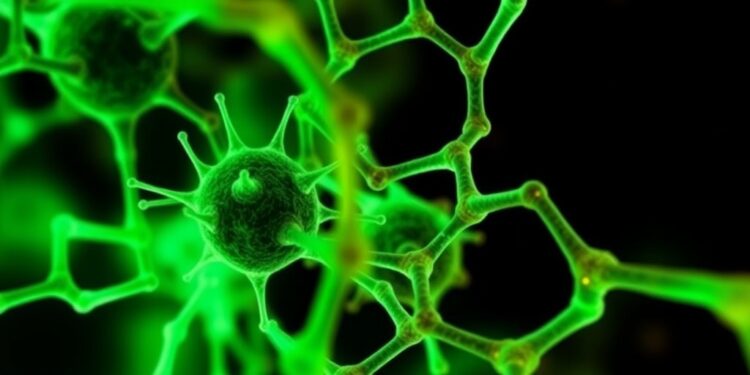Recent advancements in the field of neurodegenerative disease research have revealed a promising new avenue for the treatment of Parkinson’s Disease (PD), a condition that currently affects millions worldwide. While traditional therapeutic approaches have made significant strides, the quest for effective treatments continues, as existing options often prove inadequate in halting disease progression. One innovative strategy that has gained traction in recent years is drug repurposing—utilizing established medications with known safety profiles to tackle new therapeutic challenges. This method is particularly vital in the context of neurodegenerative diseases, including PD, where the the search for effective treatments is critical.
A recent study investigated the neuroprotective capabilities of compounds designed to mimic polysialic acid, specifically 5-nonyloxytryptamine oxalate (5-NOT) and epirubicin (Epi), an anti-cancer agent. Researchers conducted their experiments using a human neuroblastoma SH-SY5Y cell line, which has long been a reliable model for studying the pathology of Parkinson’s Disease. The study employed this model to understand better how these compounds might allow for the survival and regeneration of neurons under stress conditions that simulate the neurotoxicity observed in PD.
In the experimental setup, SH-SY5Y cells were subjected to MPP+, a neurotoxin that induces toxicity reminiscent of the dopamine depletion seen in Parkinson’s patients. The team exposed these cells to 500 µM MPP+ before treating them with either 5-NOT or Epi. This treatment paradigm was designed to elucidate the neuroprotective effects of the compounds and gauge their potential mechanisms of action. The marked emphasis was placed on cellular survival, morphological integrity, and alterations in the expression of proteins linked to neuroplasticity and cell survival.
The analysis confirmed a significant protective effect from both 5-NOT and Epi, which enhanced cell survival despite the toxic onslaught induced by MPP+. Of particular note was the preservation of cellular and nuclear morphology, which indicated that the compounds successfully mitigated the morphological alterations typically associated with neurodegeneration. Importantly, the expression levels of microtubule-associated protein 2 (MAP-2) and polysialylated neural cell adhesion molecule (PSA-NCAM) were positively regulated, suggesting that these compounds could play a crucial role in supporting synaptic integrity and plasticity.
Additionally, the findings revealed that 5-NOT and Epi exerted neuroprotective effects by restoring critical biochemical markers, including nitric oxide and matrix metalloproteinases, involved in cellular signaling and structural remodeling. These results highlight the potential of these compounds to modulate the biochemical landscape within neurons, promoting not just survival but potentially functional recovery.
In an exciting twist, the study identified that 5-NOT appeared to specifically influence the intrinsic apoptotic signaling pathway involving AKT and BAD proteins. This pathway is pivotal in regulating cell death and survival; thus, the compound’s ability to modulate it could offer significant implications for therapeutic strategies aimed at neuronal preservation in Parkinson’s Disease. Furthermore, 5-NOT’s interactions with P-38 MAP kinase signaling pathways present another avenue through which it may exert its beneficial effects, potentially facilitating neuroplastic responses crucial for recovery.
These insights position 5-NOT as a frontrunner in the search for drug candidates that can address the underlying neurodegenerative processes seen in PD. Given its dual action on both apoptotic pathways and molecular markers of neuroplasticity, it paves the way for future investigations exploring the full therapeutic potential of 5-NOT and its polysialic acid mimicking properties. The researchers argue that the findings support the notion that targeting PSA functions via mimetics could represent a novel therapeutic paradigm not only in PD but also in other neurodegenerative conditions, reinforcing the versatility of drug repurposing efforts in neuroscience.
The implications for clinical practice are profound. Should further studies validate these findings in vivo, 5-NOT may soon find itself among the ranks of treatments aimed at halting, or at least slowing, the progression of Parkinson’s Disease. Moreover, this could signify a broader movement within the pharmaceutical industry toward recognizing the potential of repurposed drugs, which could significantly reduce the time and cost associated with developing new therapeutics.
Future research directions should include expanding the investigation of the effects of 5-NOT and Epi beyond neuronal cell lines. Animal studies will be essential to clarify the in vivo efficacy and safety profile of these compounds in models of Parkinson’s Disease. Additionally, understanding the molecular mechanisms at play will be critical for tailoring future therapies that could maximize the neuroprotective effects while minimizing potential side effects.
In summary, this groundbreaking study introduces two potentially transformative compounds in the fight against neurodegenerative disease, emphasizing the power of drug repurposing in addressing unmet medical needs. As we venture into an era of tailored medicine, the lessons learned from these initial findings could benefit countless patients battling the debilitating consequences of Parkinson’s Disease.
Subject of Research: Neuroprotective potential of polysialic acid mimicking compounds for Parkinson’s Disease treatment
Article Title: Re-purposing 5-Nonyloxytryptamine and Epirubicin as Polysialic Acid Mimetics for Protection from MPP+-induced Cytotoxicity in Human Neuronal Cells
News Publication Date: 25-Mar-2025
Web References: Journal of Exploratory Research in Pharmacology
References: DOI: 10.14218/JERP.2024.00038
Image Credits: N/A
Keywords: Parkinson’s disease, neurodegenerative diseases, drug repurposing, polysialic acid mimetics, neuroprotection, SH-SY5Y cells, neuroplasticy, AKT/BAD pathway, P-38 MAP kinase, epirubicin, 5-Nonyloxytryptamine, synaptic integrity




